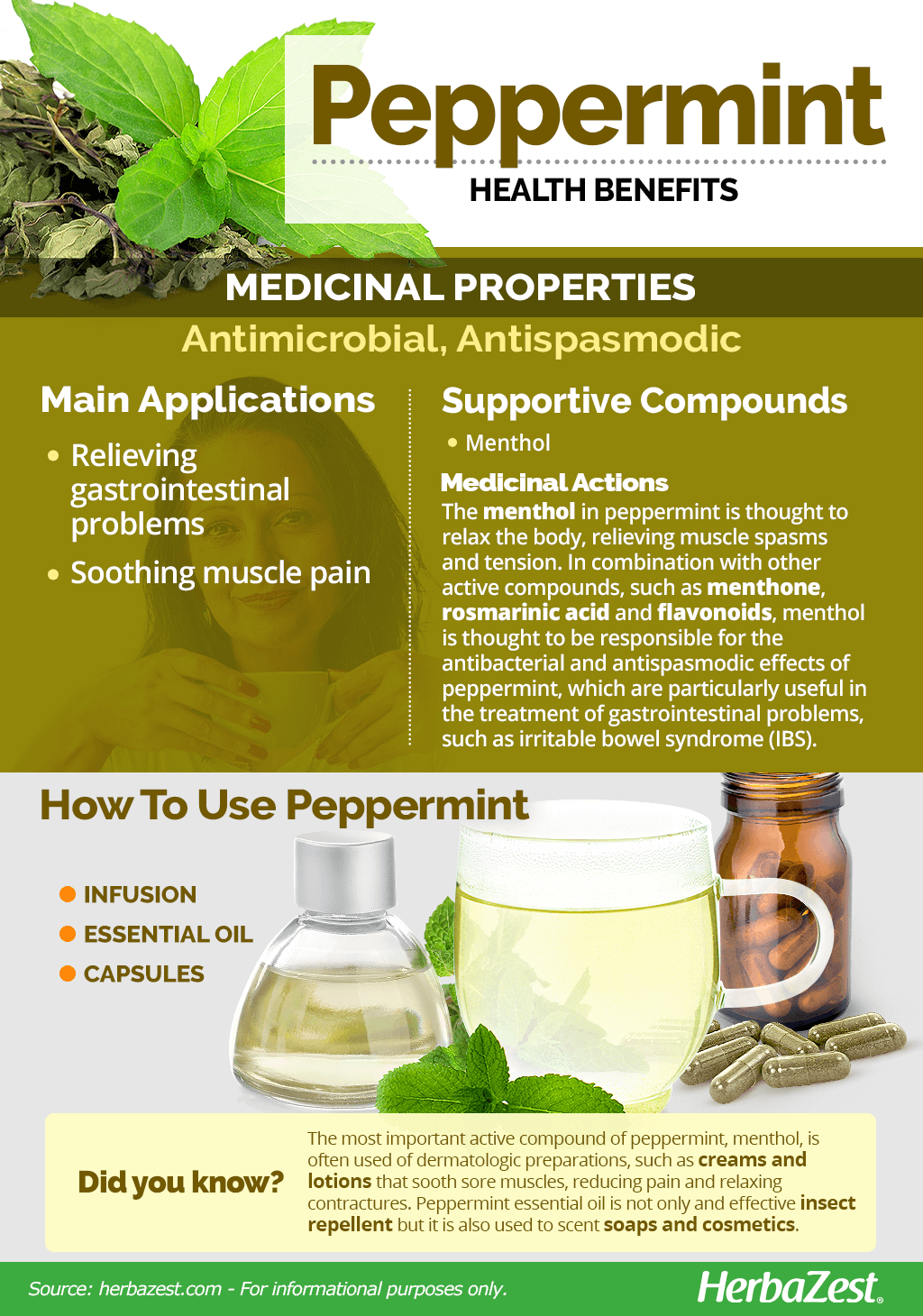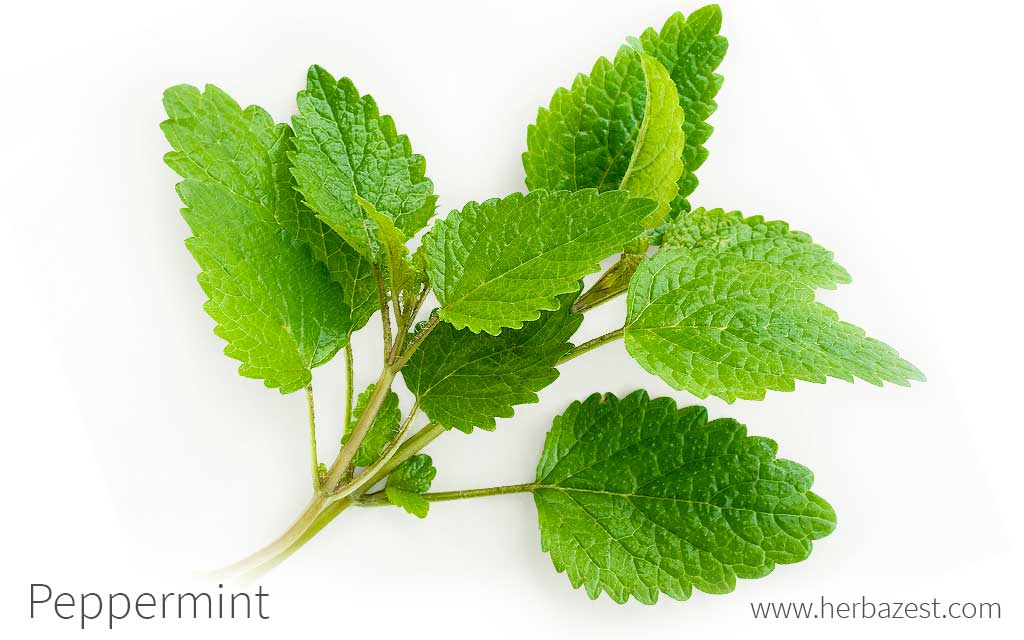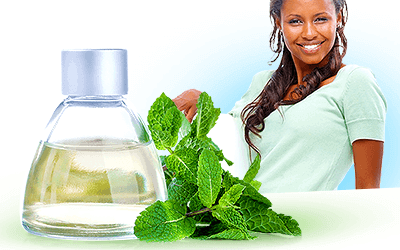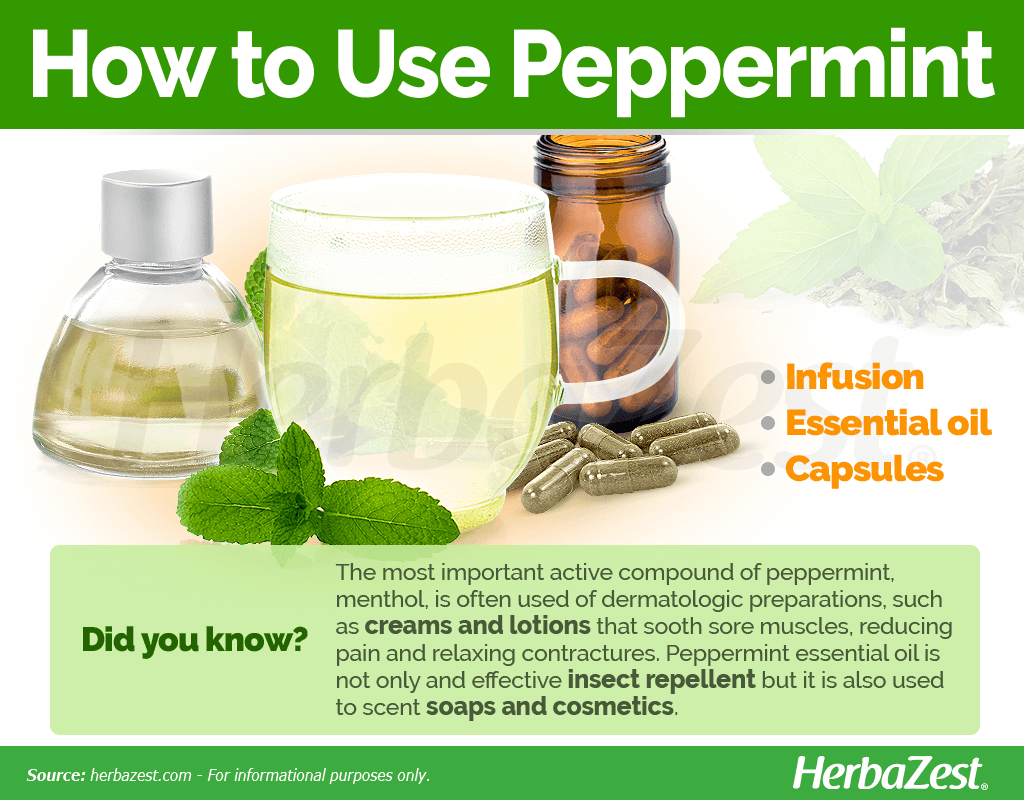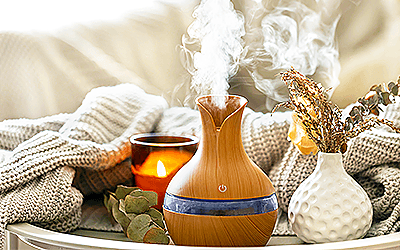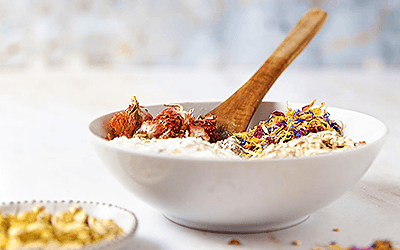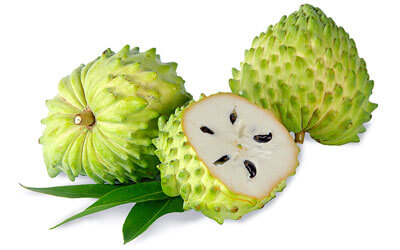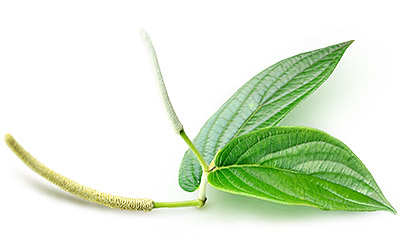When first described by Carl Linnaeus in 1753, peppermint was thought to be a distinct, indigenous plant native to Europe at large. It was later discovered that the herb is a naturally-occurring hybrid of spearmint and watermint, and it can be found wherever its parent species grow together. This herb is valued for its extensive culinary and medicinal applications.
Peppermint Medicinal Properties
Health Benefits of Peppermint
Throughout its long history, peppermint has been used in many ways thanks to its antispasmodic and antimicrobial properties, including:
Relieving gastrointestinal problems. The antispasmodic properties of peppermint has been traditionally used to soothe stomach aches, nausea, and irritable bowel syndrome (IBS).
Soothing muscle pain. The essential oil of peppermint has been popularly used to calm muscle pain and spasms.
Peppermint is also commonly used for:
Treating infections. Peppermint antimicrobial action inhibits the growth of viruses, bacteria, and fungi.
Relieving oral pain. Menthol in peppermint reacts with cold receptors in the mouth, cooling it and relieving pain.
Soothing itchy skin. Similar to relieving oral pain, menthol can stimulate a cooling sensation in the body, which can relieve pain and itchiness.
How It Works
The main compound in peppermint is menthol, which makes up about 30 - 40% of the plant's essential oil and interacts with cold receptors in the body, providing a cooling sensation. Menthol is thought to relax the body, relieving muscle spasms and tension.1,2
Its menthone and rosmarinic acid are also thought to be therapeutic, in addition to its several flavonoids. All these compounds are believed to be responsible for the antibacterial and antispasmodic effects of peppermint, particularly useful in the treatment of gastrointestinal problems, such as irritable bowel syndrome (IBS).3
Although peppermint is not particularly known for having substantial micronutrient levels, its leaves contain small amounts of calcium and potassium as well as vitamins A (retinol) and C (ascorbic acid).
PEPPERMINT OIL RELAXES GASTROINTESTINAL TISSUE, RELIEVING INFLAMMATION AND IRRITABLE BOWEL SYNDROME (IBS).
Herbs that also help with gastrointestinal issues are chamomile and rosemary, whereas sweet birch and ginger are effective for soothing muscle pain and inflammation. Additionally, antimicrobial properties can also be found in calendula and thyme.
Peppermint Side Effects
For most people, ingesting fresh peppermint or using its essential oil is generally regarded as safe. However, it can occasionally cause some adverse reactions, including heartburn, headaches, and mouth sores.
Cautions
Peppermint consumption should be avoided if a person is suffering from diarrhea or digestive conditions that involve an insufficient hydrochloric acid production.
- Medicinal action Antimicrobial, Antispasmodic
- Key constituents Menthol
- Ways to use Capsules, Hot infusions/tisanes, Liquid extracts, Food, Freshly ground, Powder, Essential oil
- Medicinal rating (3) Reasonably useful plant
- Safety ranking Safe
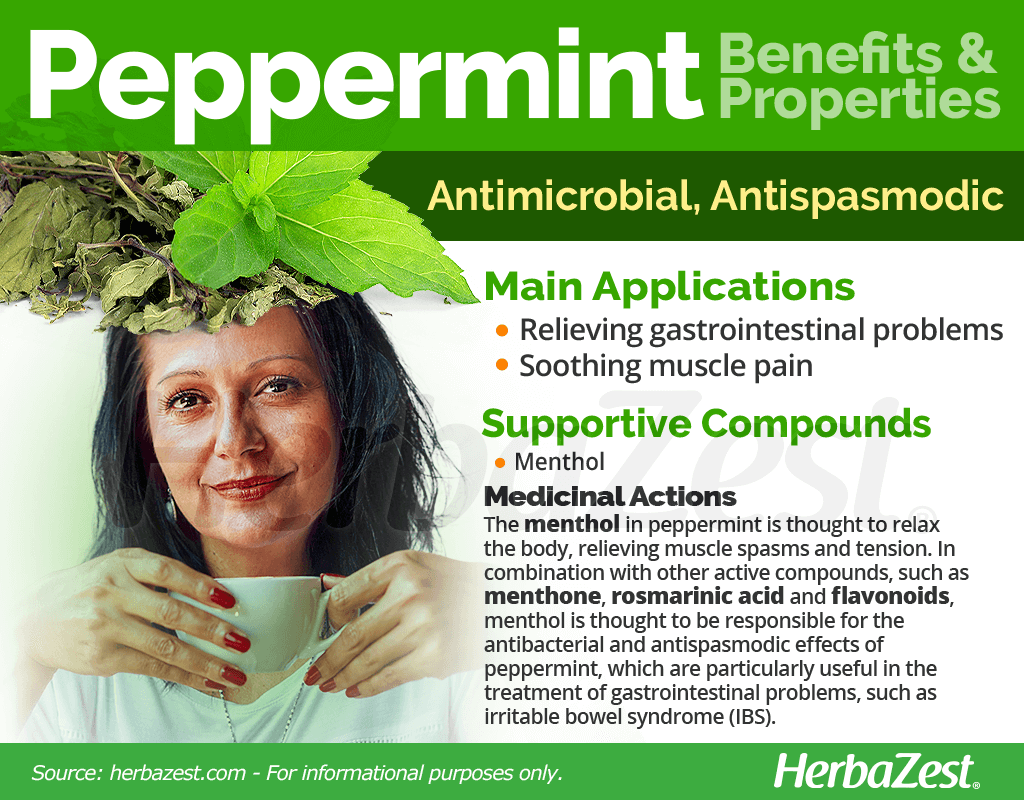
How to Consume Peppermint
Peppermint is very popular in the kitchen, where its leaves are used both as a garnish and as an ingredient in lemonades, desserts, savory stews, and much more. Its liquid extract is a common baking essential, particularly in Western cultures, where peppermint goods are often associated with the holidays. Although it is used mostly for flavoring, peppermint culinary applications also bring its antispasmodic and mouth-refreshing benefits. However, in order to make the best out of its benefits, it is recommendable to consume it in medicinal forms.
Natural Forms
Infusion. Peppermint leaves can be easily found fresh and dried (both loose and in tea bags). It is usually drank as a hot infusion to reap its digestive and antispasmodic benefits.
Herbal Remedies & Supplements
Main preparations: capsules, essential oil, infusion
Essential oil. This formulation can be rubbed on temples, sinuses, forehead, and back of the neck to relieve pressure and headaches. It can also be used in small amounts in tea to help digestion, as well as to relieve constipation, fever and infections. Peppermint oil can also be directly applied to skin to treat lesions, such as cold sores and acne.
Capsules. Peppermint capsules offer a high content of menthol and methyl salicylate. They are usually recommended for IBS pain and spams. Its active components relax stomach muscles and soothe the intestinal tract.
- Edible parts Leaves
- Edible uses Flavoring, Sweetener
- Taste Sweet, Pungent
Growing
Peppermint is native to Europe, but it is widely cultivated in North America, where it is found in damp areas, including Minnesota, Florida, and Tennessee. With a resilient root system and flexible sunlight requirements, peppermint is a favorite among gardeners for its easy cultivation. Its showy and fragrant flowers attract bees and butterflies.
Growing Guidelines
Peppermint grows best in well-drained, fertile, loamy soils in full sun to partial shade. Soil pH should be kept within the range of 5.5 - 7.0.
It is often grown in containers to prevent rapid spreading, but when grown in the ground, plants should be placed about 20 inches (50 cm) apart.
This perennial grows best when it receives its requisite one inch (2.5 cm) of water a week for proper development.
It needs a light mulch to retain moisture and keep leaves clean.
Peppermint does not bear seeds. To propagate, the plant commonly spreads from its rhizomous roots, which can form new shoots if separated from the main stem.
Harvesting is best from mid to late summer, or when temperatures hover between 60 - 80°F (16 - 26°C).
The stem should be cut about one inch (2.5 cm) from the ground just before the plant flowers. Peppermint can be harvested two to three times in a single growing season.
As well as other mints, a number of diseases can affect peppermint, and insects, weeds, and nematodes can also cause problems.
- Life cycle Annual
- Harvested parts Leaves
- Light requirements Full sun, Partial shade
- Soil Medium (loam), Well-drained
- Soil pH 5.6 – 6.0 (Moderately acidic), 6.1 – 6.5 (Slightly acidic)
- Growing habitat Cool temperate regions, Temperate climates, Humid regions
- USDA Plant Hardiness Zones 4a, 4b, 5a, 5b, 6a, 6b, 7a, 7b, 8a, 8b, 9a, 9b
- Propagation techniques Cuttings, Divisions
- Potential insect pests Mites, Nematodes
- Potential diseases Verticillium wilt
Additional Information
Plant Biology
Peppermint is a small perennial, 3 - 4 feet (91 - 122 cm) high. The square stems are usually reddish - purple and smooth, erect and branching. The leaves are from one to two inches (30 -61 cm) long, about half as wide, pointed, and with sharply toothed margins.
Peppermint flowers are purple - pinkish and appear in the summer months, from July to September. The small purplish blossoms are placed in circles around the stem, forming thick, blunt spikes. Herbaceous and rhizomatous, its fleshy roots spread widely.
Classification
Peppermint, scientifically called Mentha piperita, is merely one of over 7,200 species of the Lamiaceae or mint family, which is known for being composed mainly of aromatic, flowering herbs and shrubs, most of them fast growing and quick spreading. Other economically and medicinally important members of the mint family are basil (Ocimum basilicum),
muña (Minthostachys mollis), rosemary (Rosmarinus officinalis), sage (Salvia officinalis), oregano (Origanum vulgare), thyme (Thymus vulgaris), and lavender (Lavandula officinalis).
Varieties and Subspecies of Peppermint
Peppermint is thought to be a natural hybrid between spearmint (M. spicata) and water mint (M. aquatica). This plant is generally sterile and produces no seeds - therefore, no known subspecies exist. Despite its stunted reproduction, vegetative growth has been so effective that it is now considered an invasive species in Australia, New Zealand, the Galapagos Islands, and the U.S.
Historical Information
Archaeological research has been able to document the human use of peppermint as far back as 1,000 BCE, since dried leaves of this plant have been found in Egyptian pyramids from the same era.
Peppermint's Latin name, Mentha piperita, comes from the Greek Mintha, the name of a nymph thought to have metamorphosed into the plant, and the Latin piper, meaning pepper.
Ancient Romans were fond of the peppermint, choosing to cultivate it for both ornamental and medicinal purposes. Thanks to its easy adaptability to different climates, it started spreading throughout Europe first, was then brought East with the spice trade routes, and later traveled to North America with British settlers in early colonial times.
Economic Data
Peppermint is currently one of the most economically important aromatic and medicinal crops produced in the U.S., which is the world largest producer. The state of Oregon alone generates roughly 2.1 million pounds of the herb worth $48 million annually. The leaves and oil alike are used in both herbal medicine and food products. Parts of southern Europe and central Asia also produce peppermint, though their markets are smaller.
Other Uses of Peppermint
Toothpaste. Thanks to a fresh scent that leaves the mouth feeling clean, peppermint is one of the most popular flavors of toothpaste available.
Flavoring agent. Some pharmaceutical drugs that don't use peppermint as an active ingredient sometimes employ its flavor to make the taste more palatable to consumers.
Insect repellents. Peppermint is a natural mosquito repellent, and its active ingredients can be found in many commercial repellents.
Perfumes and cosmetics. Peppermint essential oil is integrated as a fragrance into soaps and cosmetics.
- Other uses Perfume, Repellent
Sources
- Purdue University, Peppermint Mentha piperita L.
- University of California, How to Manage Pests, Peppermint
- USDA Plants Database, The cultivation of Peppermint and Spearmint
- Encyclopedia of Herbal Medicine, p. 116
- MedlinePlus Herbs and Supplements, Peppermint
- USDA Nutrient Database, Basic report 02064: Peppermint, fresh
- Medicinal Plants of the World, pp. 205-7
- Phytotherapy Research, A review of the bioactivity and potential health benefits of peppermint tea (Mentha piperita L.), 2006
- Dermatitis, Mentha piperita (peppermint), 2010
- Phytomedicine, Peppermint oil in irritable bowel syndrome, 2005
Footnotes:
- Journal of Clinical Pharmacy and Therapeutics. (2018).The role and mechanism of action of menthol in topical analgesic products. Retrieved February 22, 2022 from https://onlinelibrary.wiley.com/doi/full/10.1111/jcpt.12679
- Journal of Sport Rehabilitation. (2021). Menthol-Based Topical Analgesic Induces Similar Upper and Lower Body Pain Pressure Threshold Values: A Randomized Trial. Retrieved February 22, 2022 from https://journals.humankinetics.com/view/journals/jsr/31/1/article-p24.xml
- Digestive and Liver Disease. (2007). Peppermint oil (Mintoil®) in the treatment of irritable bowel syndrome: A prospective double blind placebo-controlled randomized trial. Retrieved February 22, 2022 from https://www.sciencedirect.com/science/article/abs/pii/S1590865807000618
